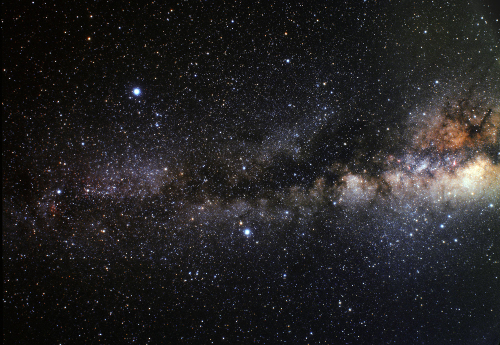Squish Like Grape
You are here
Olbers' Paradox
Primary tabs
“It ain’t what you don’t know that gets you into trouble,” Mark Twain once said. “It’s what you know for sure that just ain’t so.”
For more than 300 years after the rise of modern science, one of the things astronomers knew for sure was that the night sky should be as bright as day. Given the size of the universe and the number of stars, every line of sight ought to lead eventually to a star, however distant. The combined light from all these stars should cause every part of the night sky to be lit. But simple observation tells us it just ain't so. This puzzle is known as Olbers' Paradox, after German amateur astronomer Heinrich Wilhelm Olbers, who popularized it in the 1800s.
Even before Olbers' time, scientists stuggled to explain the darkness of the night sky. Thomas Digges proposed in 1576 that light from distant stars was just too feeble to reach us. Johannes Kepler opined that the universe is enclosed by a dark boundary wall. Others suggested that the starlight was blocked by cosmic dust, or that stars are not randomly distributed but are gathered in clusters. That last idea has some merit, astronomers have more recently confirmed, but the universe is not nearly clumpy enough to account for the dark night sky.

The poet Edgar Allan Poe, a contemporary of Olbers--and likewise an amateur--suggested in an essay that the night sky was dark because the light from the most distant stars hadn't yet reached us. The professional cosmologists ignored him. At the time, although it was fashionable for theologians like John Lightfoot and James Ussher to try to calculate the age of the universe by adding dates from the Bible, scientists still operated under the assumptions of philosophers Giordano Bruno and Rene Descartes, who had postulated an infinite and uniform universe. Given an infinite amount of time, there could be no star so distant that its light has not yet reached us.
At the beginning of the 20th century, Lord Kelvin gave Poe's idea some unexpected support when he announced, based on his studies of heat conduction, that the earth was around 20-40 million years old--a conclusion that drew criticism from both his fellow physicists and his fellow Christians. As it turned out, Kelvin's numbers were wrong but he was on the right track.
Edwin Hubble gave Poe's idea a firm scientific footing in the 1920s when he observed through the world's first 100-inch telescope that most other galaxies were moving away from ours. It seems like a simple observation, but it has several implications.
First, it means the universe is expanding. And that means the universe could not be infinitely old. If the universe is expanding through time, then if we could go back in time we would see it shrinking. Go back far enough, and we would reach a point where we could go no further. We would reach the beginning of time. Although most scientists now agree that the beginning was 13.7 billion years ago rather than 20 million, Kelvin was correct in his insistence that the universe was not eternal. And Poe was correct in that there could be stars too distant for their light to have reached us yet.
Additionally, the expanding universe means that distant star light is not moving toward us at the speed of light. Or rather, as it approaches us at the speed of light, the space between us expands, so it appears to be slower. If a star is 400 light years away from us, it will take more than 400 years to reach us, because it will have to travel through additional space that will be created during the journey. If it is 15 billion light years away, the space between it and us is expanding so fast that the star's light will never reach us.
But beyond that, because of the expanding universe, by the time the light waves do reach us they won't look the same. Similar to the way the Doppler effect makes a train whistle sound higher pitched as it approaches and lower pitched as it passes by, light waves appear to be shifted toward the red end of the spectrum if the source is moving away from us, and toward the blue end of the spectrum if it is moving toward us. If the source is far enough away, the expanding space will shift the waves out of the visible spectrum entirely; stars that are too distant are simply invisible to us.
For centuries astronomers wondered how, in an infinite universe, the night sky could be dark. It wasn't their logic that was flawed, it was their shared assumptions. Only when new observations collided with the prevailing world view could those assumptions be called into question. And only when the discrepancies became too obvious to ignore could the old assumptions finally be discarded.
Our generation is no better. When people of the future look back at the 21st century, they will probably shake their heads at the assumptions we all take for granted. That's why it's not a bad idea sometimes, when we are confronted by information that clashes with our own world view and challenges what we think we know, to deal with it honestly rather than dismiss it.
Theme by Danetsoft and Danang Probo Sayekti inspired by Maksimer


